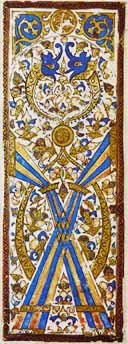jmd
(again, I've lost my earlier entry... must get used to these tabs! I'll try to re-write what took me ages to formulate reasonably clearly)
We often read that the four suits are descendents of the Mamluk deck, and that these are possibly further connected to Chinese money or domino cards.
Of the chinese connection, part of this is also due to the similar term used for what is depicted on the Mamluks as a cup, but on the Chinese as a (old) man - clearly anathema for a Muslim deck.
Of the suit, the Chinese have, certainly in the early versions, three suits of coins, 'tìao' and 'wan'. The last of these refers to thousands and is depicted by the old man. What is interesting with 'tìao', however, is that at one level it simply means 'stick', and is depicted by bamboo. At another, it seems to imply or even mean 'hundred'. The game thus seems to depict cards for tens, hundreds and thousands, depicted with allusions to what these 'same' words may have indicated in either speech or similarity.
The simple sticks, then, may have become the more elaborate polo sticks of the Mamluk deck, and the old man replaced with a cup - perhaps even as container for the elixir of longevity.
When European eyes looked at the Mamluk, it is little surprise that polo sticks may not have been recognised, as the figures look more like either stylised torches with flames atop, or glaives - polearms with large cutting blades atop.
In any case, the transformation from the Mamluk depictions to the familiar Tarot ones would have quite legitimately have caused those interested in these to also reflect on the fourfold basis of the world as then considered, with the four elements being in reasonably common parlance. That these reflections did not reach us in written form certainly makes this conjecture only that - yet, given the times, and given that there were already documents on allegorical reflections on both chess and dice, this is only the more feasible: not all that is discussed is written, and not all that is written survives...
Just additional reflections upon which to sharpen one's blade...
attached is the four of sticks from the Mamluk, for those who have not yet seen it...
We often read that the four suits are descendents of the Mamluk deck, and that these are possibly further connected to Chinese money or domino cards.
Of the chinese connection, part of this is also due to the similar term used for what is depicted on the Mamluks as a cup, but on the Chinese as a (old) man - clearly anathema for a Muslim deck.
Of the suit, the Chinese have, certainly in the early versions, three suits of coins, 'tìao' and 'wan'. The last of these refers to thousands and is depicted by the old man. What is interesting with 'tìao', however, is that at one level it simply means 'stick', and is depicted by bamboo. At another, it seems to imply or even mean 'hundred'. The game thus seems to depict cards for tens, hundreds and thousands, depicted with allusions to what these 'same' words may have indicated in either speech or similarity.
The simple sticks, then, may have become the more elaborate polo sticks of the Mamluk deck, and the old man replaced with a cup - perhaps even as container for the elixir of longevity.
When European eyes looked at the Mamluk, it is little surprise that polo sticks may not have been recognised, as the figures look more like either stylised torches with flames atop, or glaives - polearms with large cutting blades atop.
In any case, the transformation from the Mamluk depictions to the familiar Tarot ones would have quite legitimately have caused those interested in these to also reflect on the fourfold basis of the world as then considered, with the four elements being in reasonably common parlance. That these reflections did not reach us in written form certainly makes this conjecture only that - yet, given the times, and given that there were already documents on allegorical reflections on both chess and dice, this is only the more feasible: not all that is discussed is written, and not all that is written survives...
Just additional reflections upon which to sharpen one's blade...
attached is the four of sticks from the Mamluk, for those who have not yet seen it...


